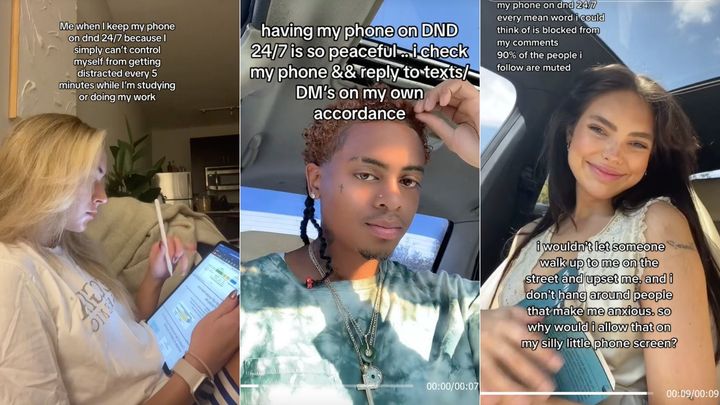As a preteen, I couldn’t resist the siren song of AIM, or AOL Instant Messenger. I’d hear that “door opening” noise or a message notification and rush to my computer, eager to see if the sign-on was my best friend or my boyfriend, both who were equally tethered to AIM at the time. (Naturally, all of our screen names usually contained the name of the person we were “dating” at the time ― NicksGirl4Eva88 was the height of romance in middle school in 2001.)
When I got my own phone not long after, I downloaded my favorite songs to use as ringtones, just like every other teenager I knew. I was as eager as ever to receive texts. (Phone calls? Those not so much. It’s true that millennials are phone call averse.)
Now that I’m in my 30s with a full time job, the thrill is categorically gone. If anything, I’m loath to look at my phone: Group texts reach obscene numbers in a matter of minutes, Slack notifications from work stack up and ruin my flow state, and there always seems to be one or two texts from a friend that I’ve been meaning to get to, but still haven’t yet. Color me surprised, then, to learn that a number of Gen Zers (and some millennials ― ones who are smarter than me) just leave their phones on “Do Not Disturb” all day. Going on vibrate isn’t enough anymore, it’s DND 24/7.
On TikTok, videos tagged “DND” and “DND 24/7” show teens and 20-somethings sharing how peaceful and productive they’ve felt since changing their notification settings.
To render your phone basically useless for the entire day is about as close to zen as I can imagine, but it also sounds weirdly frightening. But the way Gen Z sees it, it’s their phone, their time and their prerogative if they need to set boundaries.
“When I’m trying to study for an upcoming exam, a new Snapchat notification or Instagram message can often send me into a downward spiral of scrolling through my social media accounts for several minutes,” said Madeline Kerestman, a 21-year-old pre-med student and social media influencer who goes on DND for chunks of the day.
If you’re busy working, a random alert hinders your progress more than you realize. A 2005 study out of the University of California at Irvine found that, on average, it takes around 23 minutes for most workers to get back on task after an interruption.
It’s not just her study flow state that Kerestman is trying to protect when she goes incommunicado, though. Like many on TikTok, Kerestman said using the feature is about “protecting her peace.” More and more, she’s trying to live in the moment rather than living for the dopamine rush of a new “like” or comment.
“I constantly receive notifications from both TikTok and Instagram that notify me of new likes, comments, and followers,” she said. “While I love this aspect of having a platform and being connected to others, it can really be stressful and distracting sometimes.”
It’s just a bonus that going on DND means dodging all the spam calls and texts the rest of us are getting hit by lately.
@madzzz1212/@lamontlaflare/@meghancurrrie
It’s pretty simple to go on DND. For Android users, swipe down from the Home screen to access the Notification Center, then swipe once more to expand the whole panel. Tap Do Not Disturb to toggle it on.
If you have an iPhone, go to Settings > Focus > Do Not Disturb. Once there, you can set times where you want your phone to go on DND and specify a list of people who will be allowed to get through while all others are silenced.

Gen Z clearly has a love-hate relationship with their phones.
DND 24/7 is just more proof that Gen Z feels inundated by tech and wants to be more digitally minimalist in how they do things. In the last few years, some teens have gotten rid of their smartphones in favor of flip phones. On TiKTok, Gen Zers document what it’s like to have a flip phone or share instructions on how to make an iPhone an app-lite “dumb phone.”
In 2022, The New York Times profiled the “Luddite Group,” a bunch of New York City teens who read in Prospect Park with a strict “no phone” rule.
“When I got my flip phone, things instantly changed,” one of the teens told the Times. “I started using my brain. It made me observe myself as a person. I’ve been trying to write a book, too. It’s like 12 pages now.”
Chinedu Kenechukwu, a 24-year-old from Lagos, Nigeria, experiences phone wariness (and weariness) as well.
“I went on DND all day on most days last year,” she told HuffPost. “I tend to be anxious sometimes, and incoming calls on my phone tend to increase that anxiety so I’d go on DND usually just to protect my peace.”
These days, Kenechukwu doesn’t have the function on, but she wouldn’t hesitate to turn it back on during times of heightened stress. That’s what it’s there for.
Lauren Larkin, a psychotherapist and founder of Lel Therapy, sees DND 24/7 as Gen Z’s attempt to course-correct and renegotiate being Very Online and overly available. Instagram, BeReal and TikTok don’t always need your attention.
“I could see Gen Z using DND as a tool to set boundaries,” she said. “It helps create a sense of control over relationships that aren’t serving them, either by being less accessible or having less access themselves to what others are doing.”
For those with attention-deficit/hyperactivity disorder, the DND function and carving out one designated time a day to respond can be a real game-changer. Those with ADHD often struggle to respond to texts (along with phone calls and emails) due to symptoms like forgetfulness, being overwhelmed or distractibility. DND gives them the chance to respond only when they’re ready.

One caveat we should mention: Setting your phone to DND when you’re bothered by your notifications or you’re setting boundaries is one thing, but there could be times where DND could be a sign of some deeper anxiety.
“If getting calls or texts makes you have racing thoughts that are difficult to control, a faster heart rate, sweating, shaking, trouble sleeping, nausea, those could be signs of an anxiety disorder,” Larkin said.
If you’re isolating, sleeping all the time (or hardly at all), aren’t enjoying what you used to enjoy, and are feeling generally hopeless and that’s why you’re shutting your phone onto DND, that could be a sign of a depressive disorder.
“It’s all about the why behind the choice,” she said. “It’s good to be curious about that so you can understand if it’s a coping mechanism for something bigger.”
Older generations may struggle to go on DND 24/7.
If you’re used to “always-on” urgency culture, DND 24/7 can be hard to process. The DND users we spoke to said they’ve received some blowback from frustrated friends and family who’ve been unable to reach them. Some people find the trend a little obnoxious; online, people joke about how satisfying it is to “hit ‘notify anyway’ to a DND Warrior.”
Older generations may wonder “why even have a phone then?” or freak out about what would happen in case of an emergency.
“My mom will always say, ‘You are on your phone constantly! Why can you not answer a text in five minutes or pick up a call right away?’ Kerestman said.
“I think generations assume that Gen Z and millennials are glued to their phones,” she said. “While this may be true to a degree, I don’t think it means we should be expected to respond within two seconds or constantly be checking our social media accounts.”
Emily Cooper, a therapist in Seattle, Washington, is a zillennial, the “micro-generation” of people born between 1993 and 1998. (They’re too old to be considered Gen Zers and too young to be millennials.)
Personally, she loves the DND feature. She always just assumes if someone really needs to get in touch with her, they’ll call her back or she’ll get to them when she gets to them. Her mom, a young Boomer, has a much different relationship with her phone.
“My mom will answer the phone just to say she can’t talk,” Cooper said. “I’m like, ‘Then just don’t answer your phone then!’ She has gotten better at it, but will still text me one of the canned responses of ‘Can I call you back?’” Cooper said with a laugh.

yongyuan via Getty Images
The therapist wonders if part of the generational difference can be chalked up to the fact that phone calls and catching someone on the phone was more of a rarity back in the day.
“For that generation, it was almost like a delicacy,” she said. “You had to be home at the right time, able to afford long distance, whereas for me, it’s always been available so I don’t really value it as much.”
“I’d rather answer quick questions or check-ins with a text at my convenience, and if it’s something more serious, I’d rather do it in person than a phone call,” she said. “I also simply don’t have that many people who call me anymore.”
Preferences may vary along generation divides, but Cooper thinks everyone could benefit from putting a premium on phone-less time: Studies have shown that notifications from phones actually release cortisol ― the bodies’ stress hormone ― and leave our brains on “high alert.” Our nervous systems truly need time to recover from those pings and vibrations we receive all day.
“Plus, I don’t think anyone should have access to us 24/7, and expecting that is a little … unrealistic,” Cooper said. “People have lives: kids, school, work, family, friends.”
Cooper thinks the only people who need around-the-clock access are parents and kids, but even then you can set up DND settings so those calls will go through.
“I think that’s a good middle ground,” she said. “Overall, in my experience, it’s been really nice to feel in control and be able to ‘opt into’ to social media and text conversations instead of feeling like they are all being thrust upon me.”


